8 Best AR-15 Scopes & Optics in 2025 — Reviews & Top Picks
Last Updated on

You might have the best AR-15 on the market, but if you’re relying on iron sights, it’s like having a Ferrari with a governor. That’s why we took the time to track down and review the eight best scopes and optics for AR-15s.
With one of these scopes, you’ll either have an optic that matches your top-notch rifle, or you’ll have one that boosts your below-average rifle to the next level.
We also came up with a comprehensive buyer’s guide that breaks down everything that you need to know before you make your purchase.

A Quick Comparison of Our Favorites
| Image | Product | Details | ||
|---|---|---|---|---|
| Best Overall |
 |
Vortex Optics Strikefire II Scope |
|
CHECK PRICE |
| Best Value |
 |
HIRAM 4-16x50 AO Rifle Scope |
|
CHECK PRICE |
| Premium Choice |
 |
Bushnell 1-6x24mm AR Optics Scope |
|
CHECK PRICE |
 |
Predator V2 Reflex Optics Scope |
|
CHECK PRICE | |
 |
Bushnell Optics Drop Zone Reticle Riflescope |
|
CHECK PRICE |
The 8 Best AR-15 Scopes & Optics — Reviews 2025
1. Vortex Optics Strikefire II Scope — Best Overall
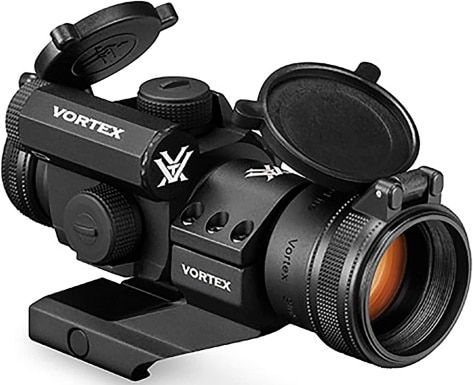
Vortex Optics is known for crafting excellent optics, and its Strikefire II Scope is no exception. It’s a pricier red dot sight, but it has plenty of features to help make up for it. For starters, there are two different reticle colors that you can cycle through: red and green.
But the most prominent perks include the ability to make wide windage and elevation adjustments, 10 different brightness settings, and crystal-clear and sharp visuals. While this sight might be a slightly more expensive option, it comes with a lifetime warranty, so it’s the last red dot that you’ll need to purchase for your AR-15.
- Two red dot colors to cycle through: red and green
- Up to 100 MOA windage and elevation adjustment
- 10 brightness settings to cycle through
- Offset cantilever mount
- Great 4 MOA red dot size
- Lifetime warranty
- A little more on the expensive side
- No magnification, since it’s a red dot sight
2. HIRAM 4-16×50 AO Rifle Scope — Best Value
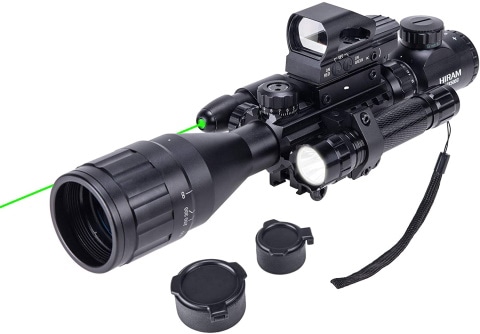
If you’re looking for the best AR-15 scope & optics for the money, you want the four-in-one HIRAM AO Rifle Scope. The traditional scope has a versatile magnification range of 4x to 16x, even though the eye relief is a little sharp between 3″ and 3.4″.
The traditional scope has an illuminated reticle, and the attached reflex sight has two different reticle colors that you can cycle through (red and green). The laser sight is extremely easy to use. Finally, there is an LED flashlight that makes it easier than ever to see your target.
However, all these features add to the size and weight of the scope, making it a little bulky and heavy. Moreover, it only comes with a 6-month warranty, and with so many features, it won’t be surprising if something breaks.
- Great magnification range on scope: 4x to 16x
- Red dot reflex sight
- Two colors to cycle through: red and green
- Illuminated reticle
- Laser sight
- Affordable for what you get
- Bulkier and heavier setup
- Only 6-month warranty
- Sharp eye relief on the scope: 3″ to 3.4″
3. Bushnell 1-6x24mm AR Optics Scope — Premium Choice
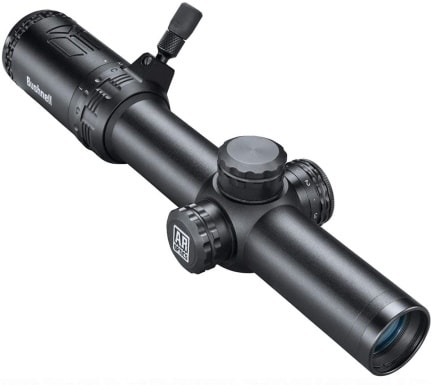
If you’re not worried about how much your new scope will cost, check out the Bushnell AR Optics Scope. It’s an excellent option for both short- and mid-range applications, with a magnification range from 1x to 6x.
Moreover, it has an illuminated reticle, the optics are bright and easy to see, and the 3.6″ of eye relief is generous. While the scope is more expensive, it does come with a lifetime warranty.
The only ding on this scope is that it’s a second focal plane reticle, but sometimes that’s exactly what you’re looking for.
- Lifetime warranty
- Great magnification range: 1x to 6x
- Illuminated reticle
- Bright and easy to see optics
- Decent 3.6″ eye relief
- More expensive option
- Second focal plane reticle
4. Predator V2 Reflex Optics Scope
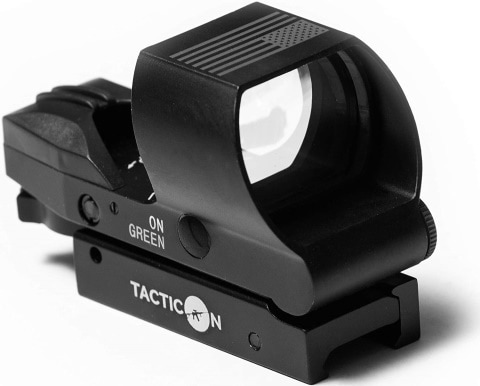
Take a look at the Predator V2 Reflex Optics Scope. Not only is it an extremely affordable option up front, but it comes with a lifetime warranty, so you don’t need to worry about it lasting.
Moreover, it comes with a 45-degree offset mount, so it’s easy to pair with a traditional rifle scope to give you the best of both worlds. However, since it is a budget choice, Predator could improve upon a few things.
Notably, there are only five brightness settings for you to cycle through, making it difficult to get the perfect brightness setting for your conditions.
- Affordable option
- Lifetime warranty
- 45-degree offset mount included
- Four reticle settings and two color settings
- No magnification because it’s a red dot sight
- Only five brightness settings
5. Bushnell Optics Drop Zone Reticle Riflescope
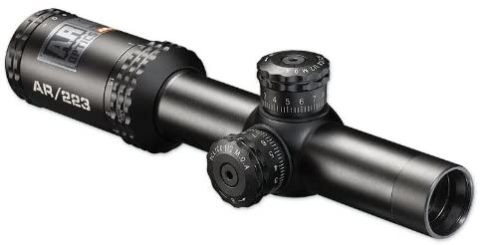
An outstanding optic for an AR-15 is the Bushnell Optics Drop Zone Reticle Riflescope. Like all Bushnell products, it comes with a lifetime warranty, which is a great deal considering this scope’s affordable, upfront cost.
Not only that, but you also get amazing clarity and crispness to go with the 1x to 4x magnification range. While that isn’t the most versatile, if you’re shooting close- to mid-range targets, it’s ideal. While we do wish that this scope were a bit lighter and had an illuminated reticle, the 3.5″ of eye relief is generous and makes it easy to use.
- Lifetime warranty
- Fast-focus eyepiece
- Great clarity and crispness
- Affordably priced
- Decent eye relief: 3.5″
- Limited magnification range: 1x to 4x
- It doesn’t have an illuminated reticle
- On the heavier side
6. MidTen Illuminated Optics Riflescope
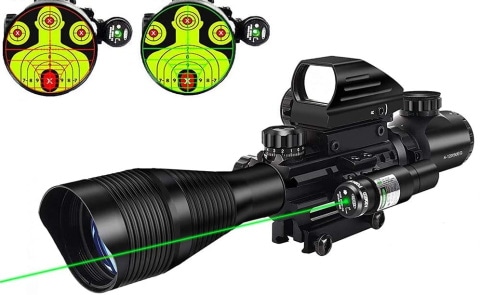
A rifle scope that has tons of options packed into it is the MidTen Illuminated Optics Riflescope. The traditional scope has a versatile 4x to 12x magnification range, and it’s affordable too. As the name implies, it has an illuminated reticle.
Moreover, it has a holographic sight mounted on top and a laser sight on the side that’s extremely easy to use. However, this scope does not come with a warranty, and the 3″ to 3.4″ of eye relief on the traditional scope is harsh.
But for all the features that are packed in, it’s an outstanding three-in-one option for your AR-15.
- Affordably priced
- Great magnification range on the scope: 4x to 12x
- Easy to use holographic sight
- Laser sight
- Illuminated reticle
- It does not come with a warranty
- Sharp eye relief on the scope: 3″ to 3.4″
7. Pinty 4-12x50EG Rifle Scope
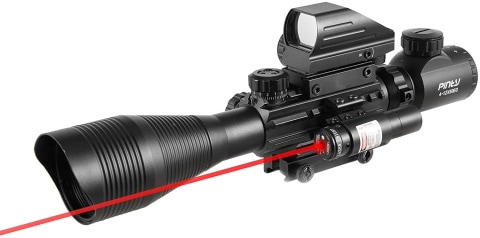
A three-in-one rifle scope for your AR-15 is the Pinty Rifle Scope. It’s an affordably priced option with a litany of features. The traditional scope utilizes a 4x to 12x magnification range, and it has an illuminated reticle on the scope.
The red dot sight has two different reticle colors that you can cycle through — red and green — and the laser sight is bright and easy to see. However, it’s on the heavier side, and it only has a 6-month warranty.
But at this price point, the shorter warranty period is acceptable, even if it’s not preferred.
- Affordably priced
- A traditional scope, red dot sight, and laser sight
- Great magnification range on the scope: 4x to 12x
- Has an illuminated reticle on the scope
- Is bulkier and heavier
- Only has a 6-month warranty
- Sharp eye relief on the scope: 3″ to 3.4″
8. CVLIFE 4×32 Tactical Rifle Scope

CVLIFE is known for making budget optics, and that’s what its Tactical Rifle Scope is. While the scope is extremely affordable, it doesn’t come with a lifetime warranty, and the eye relief is extremely sharp at only 3″.
Making matters worse is the fact that it only has one magnification setting at 4x. While it has an illuminated reticle, there are only three brightness settings. However, there are three different colors that you can cycle through: green, red, and blue.
The optics are bright and easy to see, and it’s easy to mount. But in the end, there are simply better options out there.
- Affordably priced
- Illuminated reticle with three colors to choose from: green, red, and blue
- Crisp and easy-to-see optics
- Easy to mount with Picatinny/Weaver rails
- Only one magnification level: x4
- Only three brightness settings
- No lifetime warranty
- Sharp eye relief: 3″

Buyer’s Guide – Choosing the Best Scopes & Optics for AR-15
With so many different options out there, we understand that you’re going to have questions. That’s why we created this comprehensive guide to walk you through everything that you need to know and answer any questions that you might have.
What Kind of Scope Do You Need/Want?
Before you can settle down on any scope, you need to decide what you want for your AR-15. Red dot sights offer unlimited eye relief but limited range, while traditional scopes allow you to hit distant targets but limit your shooting positions a bit.
That’s why we recommend getting the best of both worlds. You can do this in two ways. First, you can get an all-in-one scope like the HIRAM 4-16×50 AO Rifle Scope with everything that you need on one setup. Second, you can mount a red dot or holographic sight on an offset mount and use a traditional scope straight up.
So, why settle for one or the other when you can get both?
What Is Eye Relief and Why Does It Matter?

Eye relief refers to the distance that you need between your scope and your eye to see everything clearly. Red dot, reflex, and holographic sights all have unlimited eye relief, but it’s a significant number to look for on traditional scopes.
If you don’t have enough eye relief when you pull the trigger, the recoil will send the scope straight into your orbital socket. Moreover, it limits your shooting positions and can become extremely uncomfortable if you’re looking through the scope for an extended period of time.
The more eye relief you can get, the better.
Do You Need an Illuminated Reticle?
There’s no doubt that an illuminated reticle is an optional perk that you don’t always need. But, if you’re shooting in low-light conditions, an illuminated reticle can be the difference between being able to line up your shot and coming up empty-handed.
This is especially important for second focal plane scopes, as it can be more challenging to see the smaller etchings on the reticle at lower magnification levels. So, while you don’t necessarily need an illuminated reticle, it’s a nice perk to have, and it makes your scope more versatile.
Brightness Settings and Red Dots

If you’re shopping for a red dot sight for your AR-15, the number of brightness settings that you have to choose from is a big deal. While you might think that as long as the reticle gets bright enough, you’re good to go, but this type of thinking has two potential drawbacks.
First, you’re going to burn through batteries if you’re using your red dot sight on maximum brightness all the time. Second, if you’re using a red dot sight that’s too bright for the conditions, the reticle will blur. This can, in turn, affect your accuracy.
First Focal Plane vs. Second Focal Plane Reticles
When you’re looking at a traditional scope, you need to know if you’re getting a first focal plane reticle or a second focal plane reticle. The difference is simple but it’s important.
First focal plane reticles always appear the same size when you look through the scope, regardless of magnification. On the other hand, second focal plane reticles only fill up the optics piece at maximum magnification.
This means a second focal plane reticle will appear smaller at less magnification, making it more difficult to see.
Offset vs. Straight-Up Mounts

When you’re selecting a scope for your AR-15, you might notice that it comes with an offset mount. This is particularly true for red dot sights and reflex sights. That’s because an offset sight sits at a 45-degree angle on your rifle, which allows you to tilt your rifle slightly to see through it.
Having an offset red dot sight or reflex sight allows you to pair it with a traditional scope and get the best of both worlds. Since the red dot sight is off at an angle, you still have an unobstructed view when you look through the traditional scope.
Keep in mind that it takes extra practice to get used to using an offset mount, but the added versatility makes it well worth it.
How Much Magnification Do You Need?
When you’re selecting a scope for your AR-15, one of the most important decisions that you must make is how much magnification you need. While it’s an extremely important question to answer, it largely comes down to personal preference.
For most applications, you won’t need more than 9x magnification, but if you’re not shooting long-range targets, 5x to 6x magnification is plenty. Also, keep in mind that with too much magnification, you’ll distort closer range targets, which means you’ll need to pair it with a red dot sight or a reflex sight to hit closer range targets with high magnification scopes.
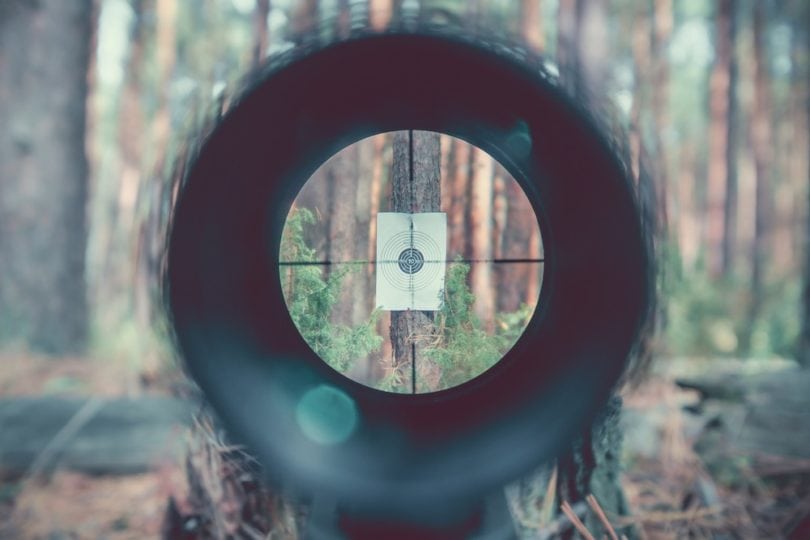
A Note on Warranties
While scopes and optics that offer a lifetime warranty are often a bit more expensive, it’s almost always worth the extra cost in the long run. That’s because while every company tells you that it has a long-lasting product, only those that offer a lifetime warranty guarantee it.
This means two things. First, if you run into problems, all you need to do is send the scope back, and the company will repair it or replace it for you for free. Second, since the company doesn’t want to deal with the warranty process any more than you do, the chances of you getting a top-notch product drastically increases.
It’s also why products that come with a lifetime warranty get a noticeable boost on ranking lists.

Conclusion
When you’re serious about hitting the range and hitting your target, these are the best scopes and optics for AR-15. If you’re not sure about what you should get, we recommend going with the Vortex Optics Strikefire II Scope and mounting it with the cantilever offset mount. From there, you should pair it with the Bushnell 1-6x24mm AR Optics Scope for the best of both worlds. However, if you’re looking for the best value for your money, the HIRAM 4-16×50 AO Rifle Scope has everything that you need in one scope at an affordable price.
Hopefully, this guide walked you through everything that you need to know to get the perfect scope for your AR-15. This way, the next time you head out, you can do it with a top-notch setup.
Featured Image Credit: Justin Kral, Shutterstock
Table of Contents
- A Quick Comparison of Our Favorites
- The 8 Best AR-15 Scopes & Optics — Reviews 2025
- 1. Vortex Optics Strikefire II Scope — Best Overall
- 2. HIRAM 4-16×50 AO Rifle Scope — Best Value
- 3. Bushnell 1-6x24mm AR Optics Scope — Premium Choice
- 4. Predator V2 Reflex Optics Scope
- 5. Bushnell Optics Drop Zone Reticle Riflescope
- 6. MidTen Illuminated Optics Riflescope
- 7. Pinty 4-12x50EG Rifle Scope
- 8. CVLIFE 4×32 Tactical Rifle Scope
- Buyer’s Guide – Choosing the Best Scopes & Optics for AR-15
- What Kind of Scope Do You Need/Want?
- What Is Eye Relief and Why Does It Matter?
- Do You Need an Illuminated Reticle?
- Brightness Settings and Red Dots
- First Focal Plane vs. Second Focal Plane Reticles
- Offset vs. Straight-Up Mounts
- How Much Magnification Do You Need?
- A Note on Warranties
- Conclusion
About the Author Robert Sparks
Robert’s obsession with all things optical started early in life, when his optician father would bring home prototypes for Robert to play with. Nowadays, Robert is dedicated to helping others find the right optics for their needs. His hobbies include astronomy, astrophysics, and model building. Originally from Newark, NJ, he resides in Santa Fe, New Mexico, where the nighttime skies are filled with glittering stars.
Related Articles:
Binocular Magnification Chart: Numbers & Distances Compared
What Is the Best Binocular Magnification for Hunting? Optical Features Explained
When Were Binoculars Invented? History, Today & Future
How to Clean a Refractor Telescope: Step-by-Step Guide
How to Clean a Telescope Eyepiece: Step-by-Step Guide
How to Clean a Rifle Scope: 8 Expert Tips
Monocular vs Telescope: Differences Explained (With Pictures)
What Is a Monocular Used For? 8 Common Functions



